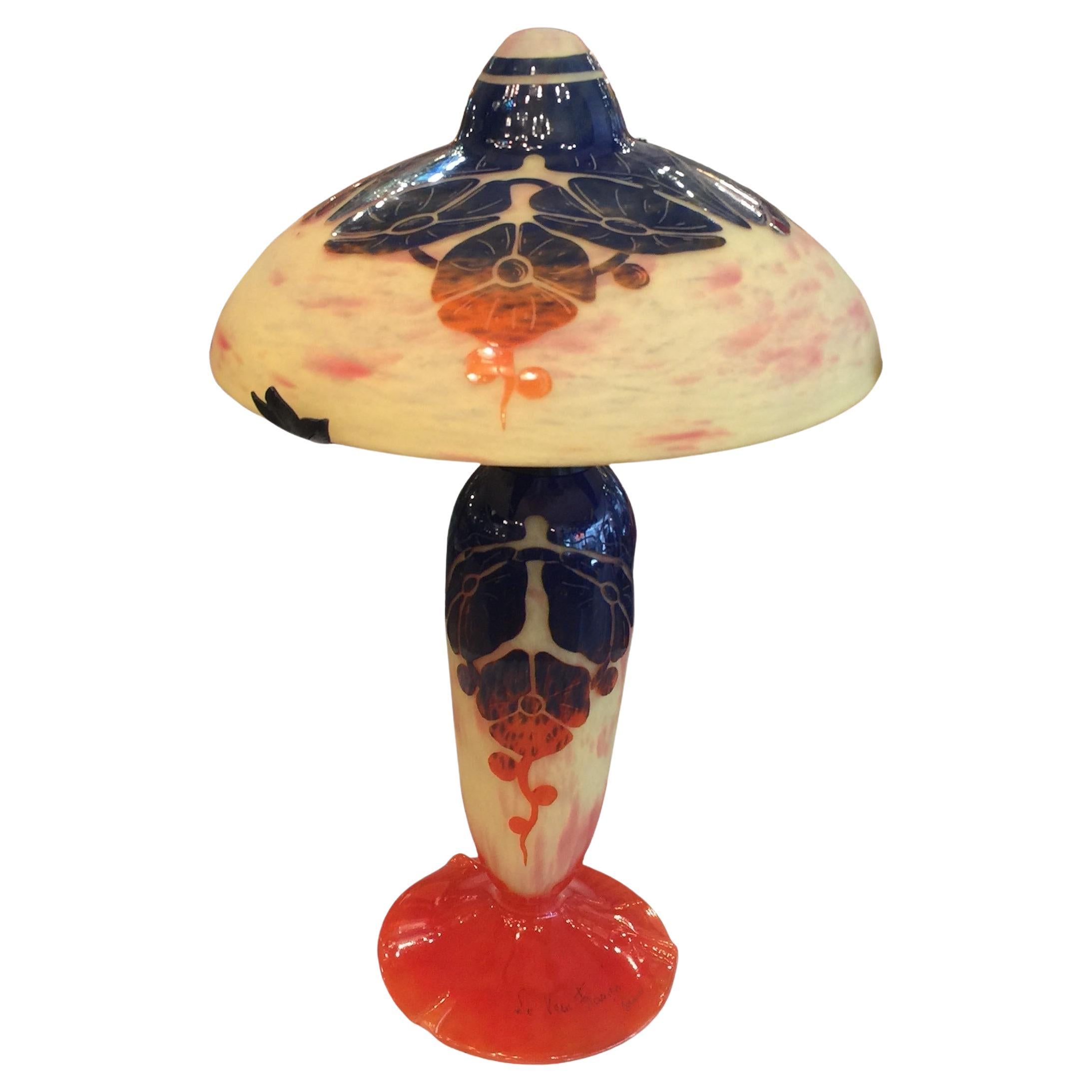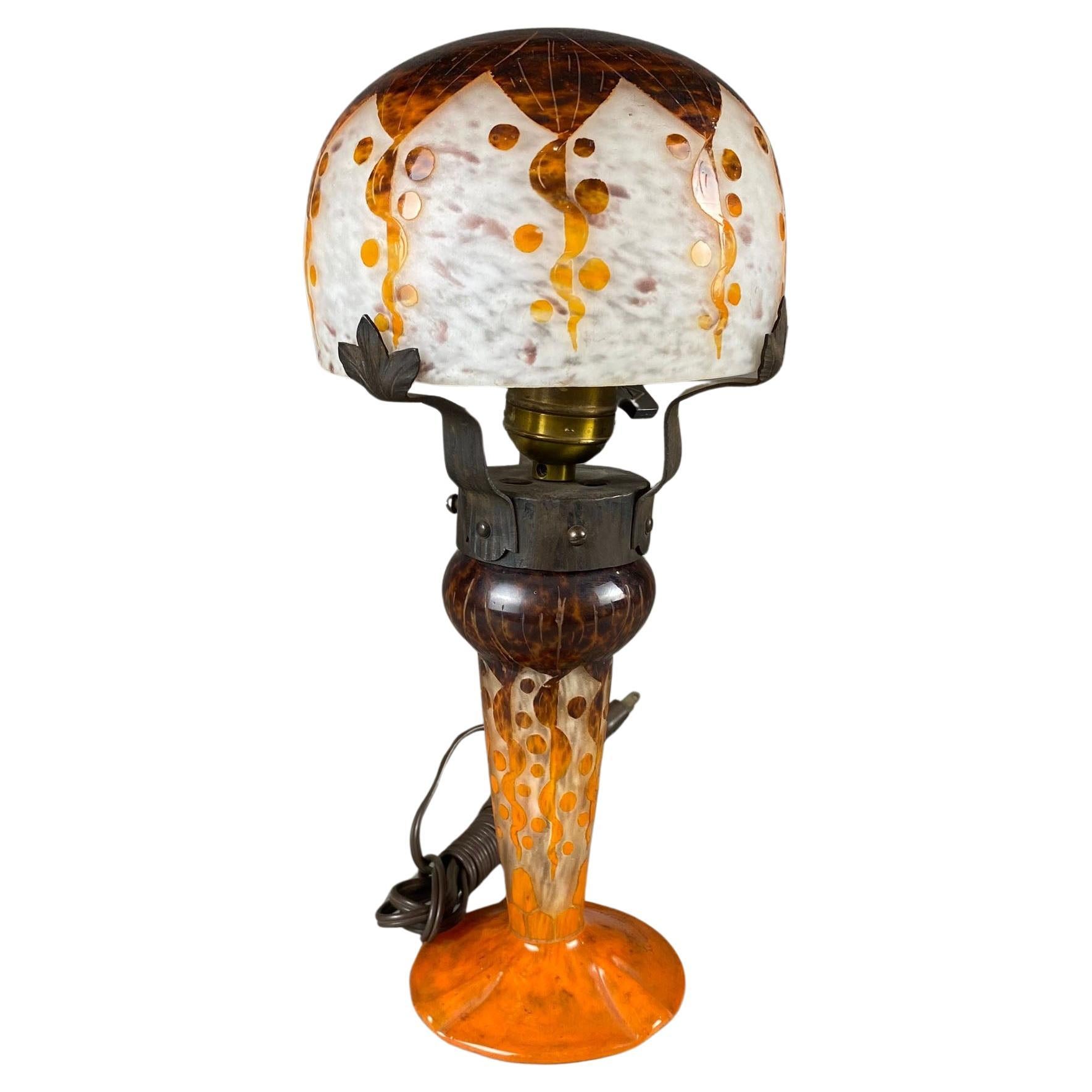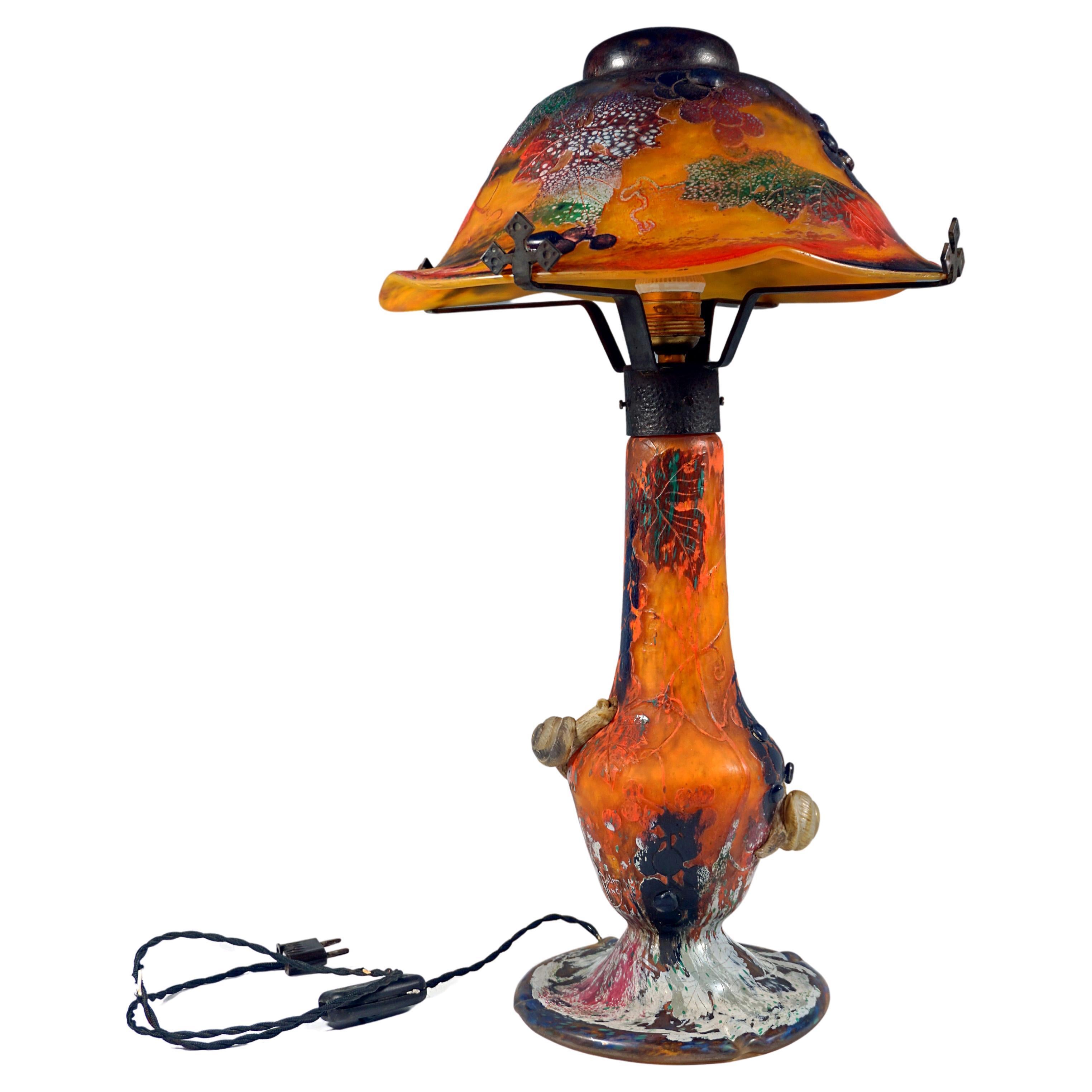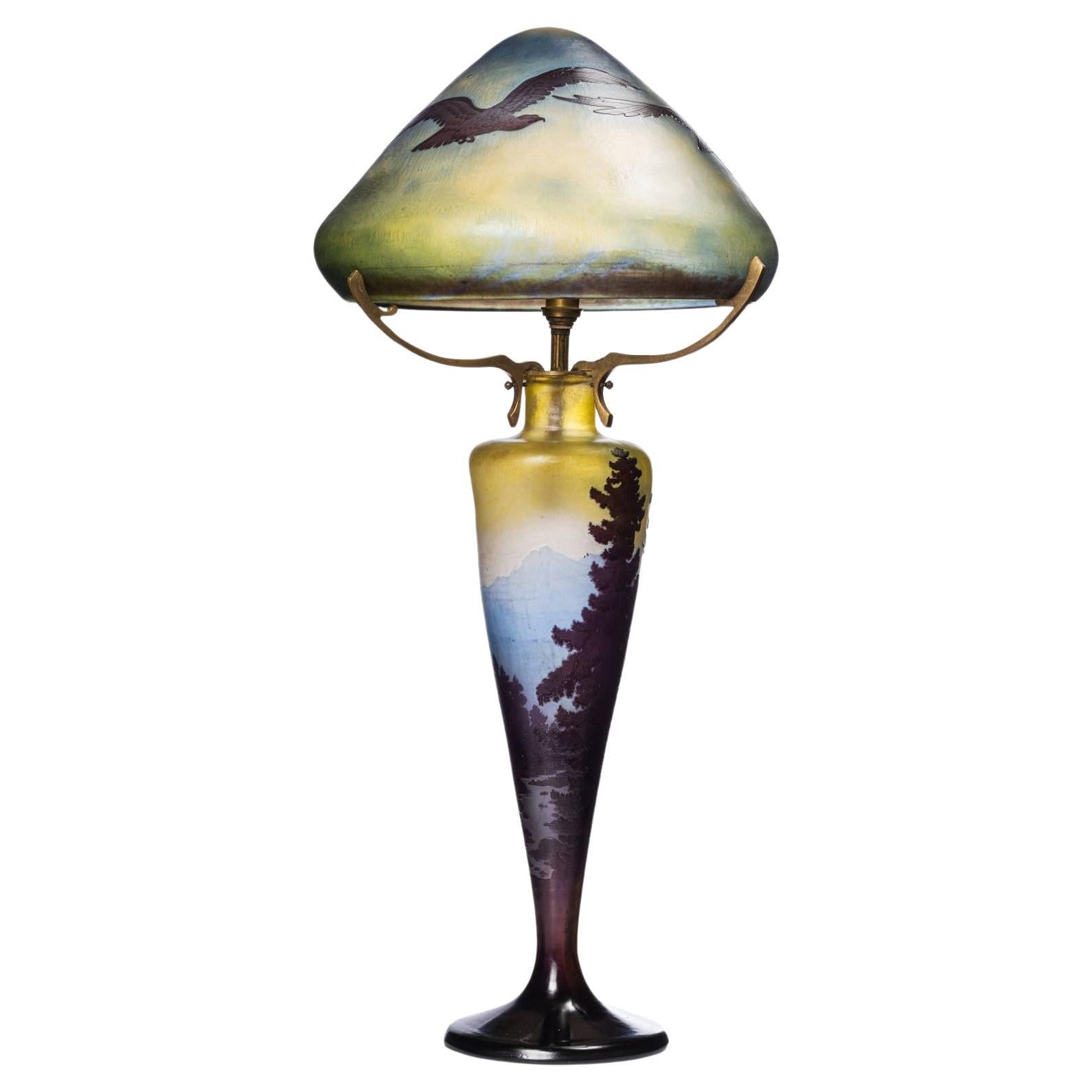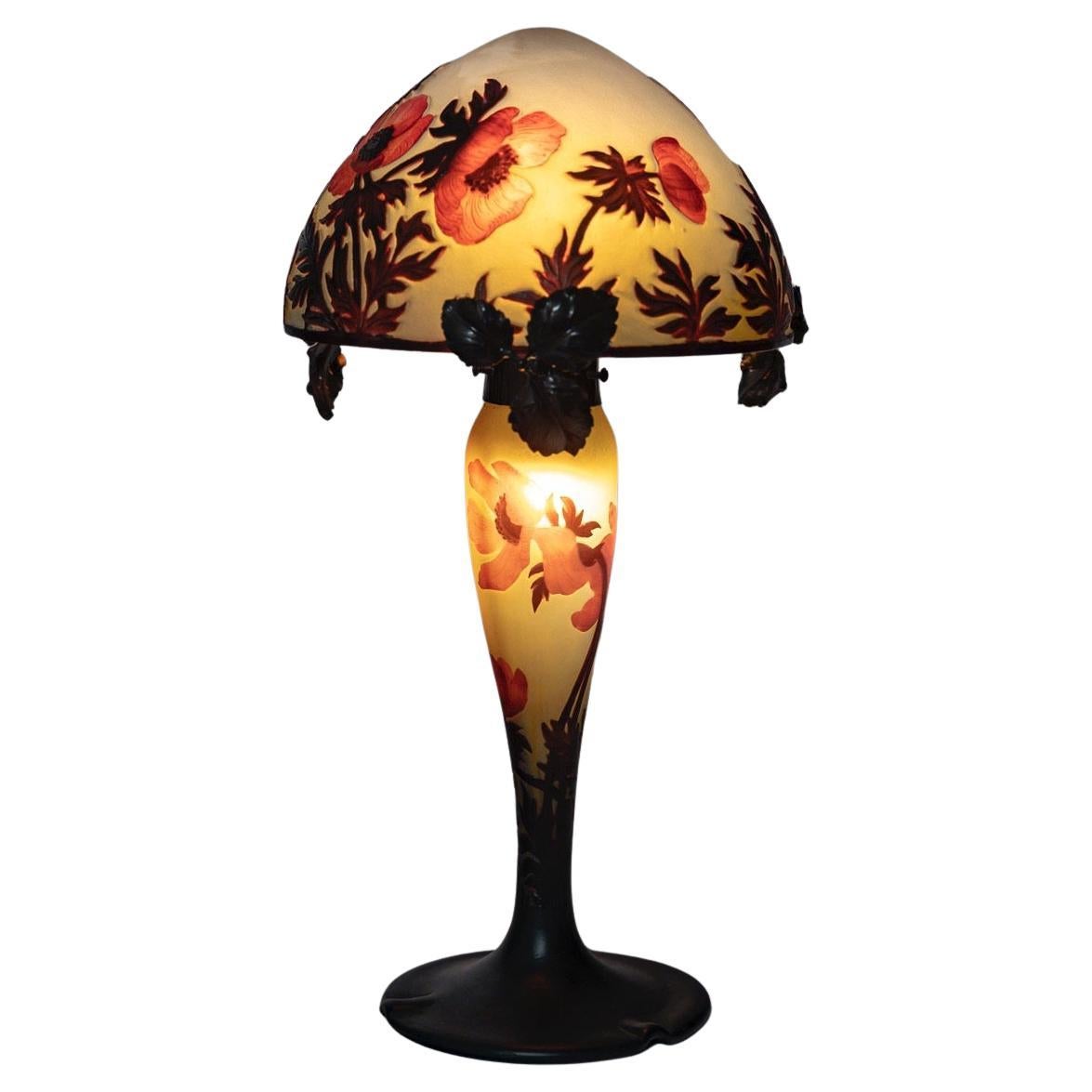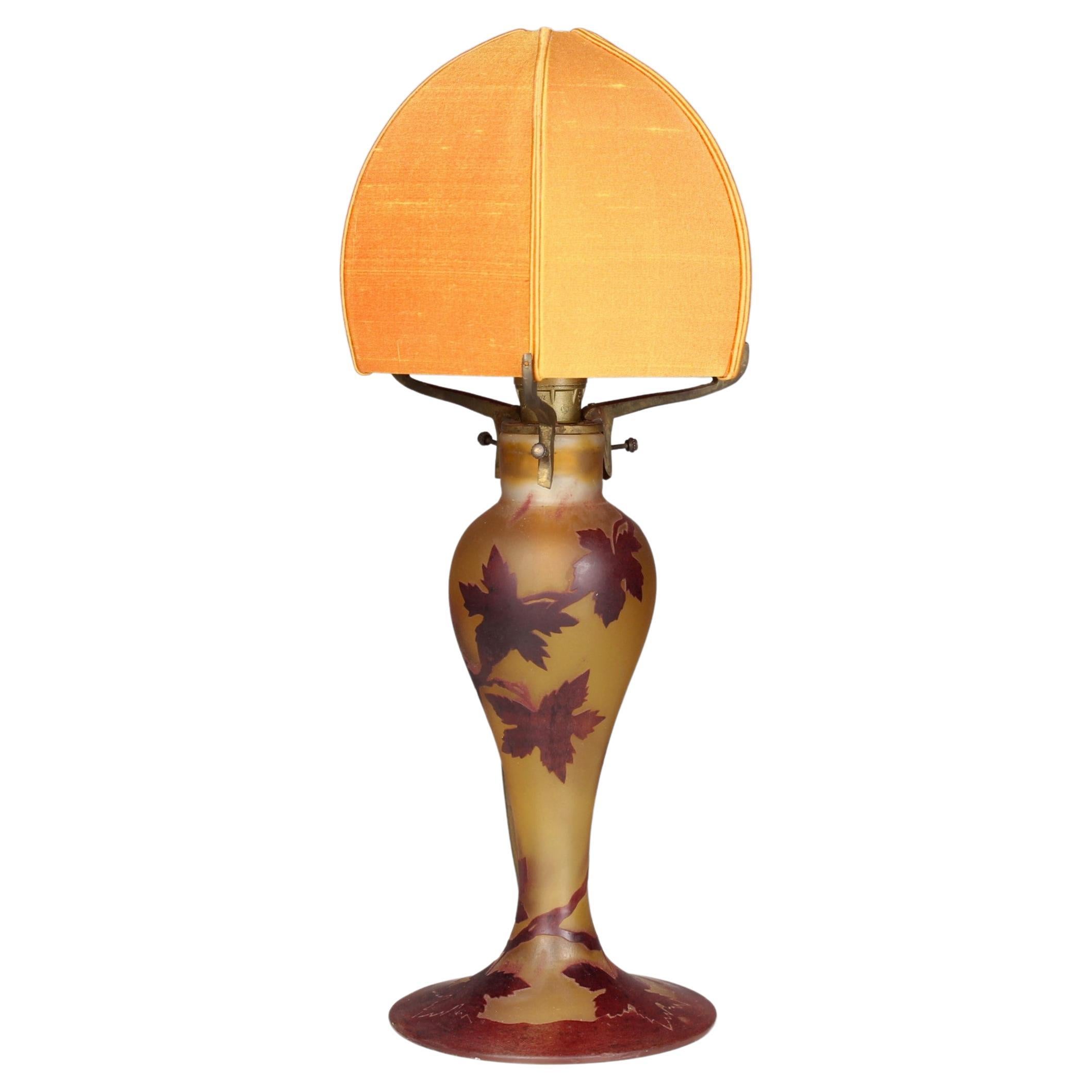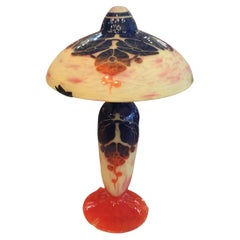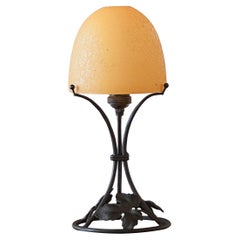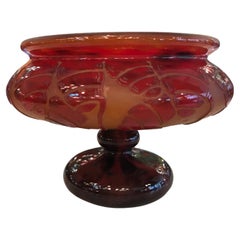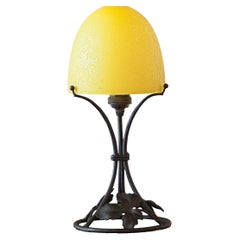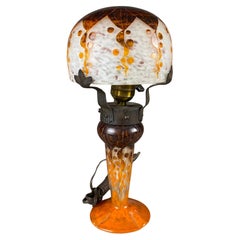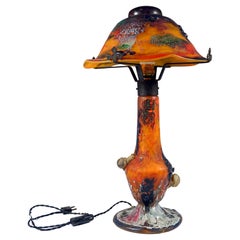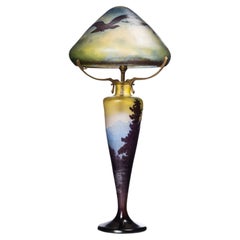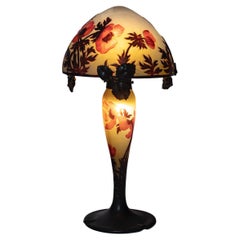Items Similar to Butterfly table lamp Sign: Le Verre Francais France, 1923, Style: Art Nouveau
Video Loading
Want more images or videos?
Request additional images or videos from the seller
1 of 21
Butterfly table lamp Sign: Le Verre Francais France, 1923, Style: Art Nouveau
$75,000
£56,968.63
€65,647.17
CA$105,618.58
A$117,093.81
CHF 61,537.37
MX$1,433,036.17
NOK 768,539.12
SEK 721,350.86
DKK 490,015.40
About the Item
Vase Sign: Le Verre Francais France
acid worked
Página: 123 libro Charles Schneider Le Verre Francais- Charder Schneider
Autora: Marie Christine Joulin- Gerold Maier
Le Verre cameo glass was a separate line of art glass designed by Charles Schneider. Its production was made at the same time as the Schneider designed glasses 1918 –1933. But from 1919 the two lines were kept strictly separate, so much so that even had the same points of sale in Paris. Several different signatures were used for Le verre glass. Early marks consist of a small tri-color glass rod, a patriotic touch representing the red-white-blue French flag, which was fused into the foot or bottom of the piece. Rather than straight, it can also appear as a tight curl. This signature is commonly referred to as a ‘candy cane’. The next signature was Le Verre Francais, engraved on the foot or near the bottom of the piece. Especially during times of changeover, pieces can have both of these signatures. Usually, the Charder signature was used in conjunction with the engraved Le Verre Francais, but some pieces are signed legitimately only in cameo with the Charder signature. In addition, many pieces are acid-stamped FRANCE on the bottom, sometimes in combination with Ovington. Ovington was a decorative arts specialty store in New York that sold Le Verre glass in the USA, and their catalogs from those years carry advertisements offering Le Verre. Charles Schneider developed the Le Verre line in a marketing move to reach a broader public taste with an aesthetically pleasing product. His grandson, Jean-Charles Schneider, states in Bertrand’s book that Charles Schneider was the first to use modern marketing techniques for decorative arts. Charles Schneider developed all the designs for both lines of glass, but for Le Verre he gave the craftsmen freedom to select color, shape and size. That explains why some designs are available in different colors, with many pieces exhibiting variable hues. For the most part they did an excellent job of adapting the design to a given shape and size. tree designs, are quite impressive as large pieces. Le Verre glass achieves its impact through a combination of design, shape and color. The relatively short time of production (1918-1933) permits a fascinating view of the transition from art nouveau to art deco. During the early years, lifelike designs of animals –swans, cats-, and plants –holly, bell flowers-, were executed in somber hues, so that just by noting the color, one can roughly date a piece. As time went on, the designs became more stylized in the art deco manner, and the colors brightened. Toward the end of the 15-year span, the production came full circle to a common finish with the Schneider line: In the early 1930s, both concluded their production with unicolor pieces, where only shape and cold decoration, like etching, determined the work’s character. Until the economic downturn in the world deprived the Schneider firm of viable markets, Le Verre glass was an unqualified success by any measure, exporting in large quantities to both North and South America, as well as selling to the European public. The work came in all sizes, from miniatures of 3" or less, to monumental sizes of 36" and more. Among the more exciting pieces are the lighting fixtures: Whether table lamps or night lights, chandeliers or plafonds, a Le Verre design lit up can be a spectacular sight and can dominate a room.
We have specialized in the sale of Art Deco and Art Nouveau and Vintage styles since 1982. If you have any questions we are at your disposal.
Pushing the button that reads 'View All From Seller'. And you can see more objects to the style for sale.
Why are there so many antiques in Argentina?
In the 1880 – 1940 there was a grate wave of immigration encouraged by the periods of war that were taking place.
1st World War took place between 1914 and 1918
2nd World War took place between 1939 and 1945
The immigrants options were New York or Buenos Aires. Tickets were cheap and in Buenos Aires they were welcomed with open arms, as it was a country where everything was still to be done.
Argentina was the country of new opportunities, labour was needed and religious freedom was assured, in many cases the of the family travel first until they were settled and then the rest of the family members join them.
In the immigrant museum “Ellis Island Immigrant Building” in New York you can se the promotional posters of the boats that would take them to a new life.
Between the years 1895 and 1896, Argentina had the highest DGP (gross domestic product) per capita in the world according to the Maddison Historical Statistics index, this situation arose due to the large amount of food being exported to European countries, which were at war.
The Argentinean ships left the port of Buenos Aires with food, but they returned with furniture, clothes and construction elements, (it´s common to see this the old buildings of the historic neighbourhood of San Telmo, the beams with the inscription “Made in England)”, as well as many markets that were built in Buenos Aires, such us the San Telmo Market, whose structure was brought by ship and afterwards assembled in 900 Defensa Street.
With the great influence of European immigrants living in the country, the children of the upper classes travelled to study in France, resulting in the inauguration of “La Maison Argentinienne”, on 27th of June 1928, in the international city of Paris, which hosted many Argentinians that were studying in Frace.
It´s the fourth house to be built after France, Canada and Belgium, being the first Spanish-speaking one. Still in place today (17 Bd Jourdan, 75014, Paris, France). Many of the children of these wealthy families who attended international art exhibitions, museums and art courses abroad, took a keen interest in the European style. This is why Buenos Aires was at the time referred as “The Paris of South America”.
Between the years 1890 and 1920 more than a hundred Palaces were built on Alvear Avenue the most exclusive avenue in Buenos Aires. Today some of these palaces have been transformed into museums, hotels and embassies.
In the year 1936, the Kavanagh building was inaugurated, it was the tallest reinforced concrete building in South America.
During 1994 the American Society of Civil Engineers distinguished it as an “international engineering milestone”, and it´s now considered a World Heritage of Modern Architecture.
At the time was common to hire foreign architects such as Le Corbusier, who visited Buenos Aires/Argentina in 1929 and in 1948 he drew up the blueprints for a house built in La Plata City (which was declared a World Heritage Site).
In 1947, the Hungarian architect Marcelo Breuer designed “Parador Ariston” in the seaside city of Mar del Plata. After an Argentinean student at Harvard University convinced him to come to Argentina. He worked on an urban development project in the Casa Amarilla, area of La Boca.
The Ukrainian architect, Vladimiro Acosta, arrives in Argentina in 1928 and worked as an architect until que moved to Brazil.
Antonio Bonet, a Spanish architect who worked with Le Corbusier in Paris, arrives in Argentina in 1937, where he carried out several architectural works and in 1938 designs the well-known BFK chair.
Andres Kálnay, of Hungarian origin, made around 120 architectural masterpieces, among which the former Munich brewery stands out, he even made the furniture’s design.
The German architect, Walter Gropius, director of the Bauhaus, lived in Argentina, where he wrote articles for “Sur” magazine and founded in Buenos Aires, an architectural firm with Franz Möller, who was also an architect, where he built two houses.
At the same time several famous designers decided to immigrate to Argentina, among them we can find the well-known French designer, Jean-Michel Frank, who arrived in the country in 1940 and also worked for the Rockefeller family.
Special pieces were made, which were sold exclusively in the country, such as the well-known German company “WMF”, who sold their products by catalogue, which were chosen by the ladies of high society in the list of wedding gifts, as well as the pieces designed by Christofle.
The Swiss sculptor Alberto Giacometti, made special pieces for Argentinean mansions.
In 1904 the first Jansen branch outside Paris was established in Buenos Aires, as the Argentinean clientele demanded a large amount of furniture, from the end of the 19th century to the mid-20th century.
In 1970, the brand Rigolleau Argentina made pieces authorised by Lalique.
The brands Maple and Thompson also set up shop in the country.
The French plastic artist, Marcel Duchamp moved to Argentina in 1918-1919.
Glass signed Gallé, Charder, Leverre, Schneider, Muller and other French firms. They were bought in flower shops and were given to ladies with beautiful floral arrangements.
Some furniture manufacturers travelled to international fairs and bough the patterns to produce the furniture in Argentina, such as the furniture firm Englander and Bonta, who bought the patterns ins Italy.
It is worth mentioning that in Argentina we have the largest community of Italians outside of Italy, as it is estimated that 70 percent of the inhabitants have at least one Italian descendant, followed by Spanish immigrants.
The most Important furniture stores in Argentina:
Comte is founded in 1934 (under the direct management of Jean Michel Frank in 1940).
Nordiska (Swedish company established in 1934).
Churba in 1960, a company that brought foreign designers to present their furniture in the country:
Denmark: (Arne Jacobsen, Finn Juhl, Bender Madsen, Ejner Larsen, Poul Kjaerholm, Hans Wegner)
Sweden: (Hans Agne Jakobsson, Gustavsberg)
United States: (Herman Miller)
Finland: (Lisa Johansson, Folke Arstrom, Tapio Wirkkala, Alvar Aalto, Timo Sarpaneva)
Swedish Factory: (Orrefors)
Italy: (Littala, Vico Magistretti, Emma Gismondi, Gae Aulenti, Angelo Mangiarotti, Elio Martinelli, Gianna Celada, Angelo Mangiarotti, Mario Bellini, Carlo Scarpa)
Finland: (Olivia Toikka)
Plata Lappas (Lappas Silver): a goldsmith shop founded in 1887 in Argentina by Alcibiades Lappas of Greek origin.
In 2019, in Argentina took place “the Art Deco world congress”, in which we participated as hosts invited by Geo Darder, founder of the Copperbridge – Foundation, in which prominent people from all over the world attended to learn about Art Deco in Argentina.
Argentina currently has more than 100 Art Deco buildings and another 90 Art Nouveau buildings throughout the city of Buenos Aires.
Argentina is a country that has not been involved in many wars, which is why it has been a refuge for works of art and antiques from different periods of time, unlike European countries. That is way many collectors, museums and antique dealers from all over the world visit it, you should not miss the opportunity to visit this great country.
Laura Guevara Kjuder, architect.
- Creator:Le Verre Francais (Designer)
- Dimensions:Height: 9.85 in (25 cm)Diameter: 9.45 in (24 cm)
- Style:Art Nouveau (Of the Period)
- Materials and Techniques:
- Place of Origin:
- Period:
- Date of Manufacture:1923
- Condition:Wear consistent with age and use.
- Seller Location:Ciudad Autónoma Buenos Aires, AR
- Reference Number:Seller: G-211stDibs: LU6785236015712
About the Seller
5.0
Vetted Professional Seller
Every seller passes strict standards for authenticity and reliability
Established in 1982
1stDibs seller since 2022
38 sales on 1stDibs
Typical response time: <1 hour
- ShippingRetrieving quote...Shipping from: Ciudad Autónoma Buenos Aires, Argentina
- Return Policy
Authenticity Guarantee
In the unlikely event there’s an issue with an item’s authenticity, contact us within 1 year for a full refund. DetailsMoney-Back Guarantee
If your item is not as described, is damaged in transit, or does not arrive, contact us within 7 days for a full refund. Details24-Hour Cancellation
You have a 24-hour grace period in which to reconsider your purchase, with no questions asked.Vetted Professional Sellers
Our world-class sellers must adhere to strict standards for service and quality, maintaining the integrity of our listings.Price-Match Guarantee
If you find that a seller listed the same item for a lower price elsewhere, we’ll match it.Trusted Global Delivery
Our best-in-class carrier network provides specialized shipping options worldwide, including custom delivery.More From This Seller
View AllTable lamp Sign: Le Verre Francais France ( Flowers Begonias ), 1922
By Le Verre Francais
Located in Ciudad Autónoma Buenos Aires, C
Vase Sign: Le Verre Francais France
acid worked
Le Verre cameo glass was a separate line of art glass designed by Charles Schneider. Its production was made at the same time as the ...
Category
Vintage 1920s French Art Nouveau Glass
Materials
Art Glass
Table Lamp, Style: Jugendstil, Art Nouveau, Liberty, Year: 1900, French
Located in Ciudad Autónoma Buenos Aires, C
To take care of your property and the lives of our customers, the new wiring has been done.
We have specialized in the sale of Art Deco and Art Nouveau and Vintage styles since 1982....
Category
Antique Early 1900s French Art Nouveau Table Lamps
Materials
Iron
Vase , Sign: Le Verre Francais France, Style: Art Nouveau, 1924
By Le Verre Francais
Located in Ciudad Autónoma Buenos Aires, C
Vase Sign: Le Verre Francais
acid worked
Le Verre cameo glass was a separate line of art glass designed by Charles Schneider. Its production was made at the same time as the Schneid...
Category
Vintage 1920s French Art Nouveau Glass
Materials
Art Glass
Table Lamp, Style: Jugendstil, Art Nouveau, Liberty, Year: 1900, French
Located in Ciudad Autónoma Buenos Aires, C
To take care of your property and the lives of our customers, the new wiring has been done.
We have specialized in the sale of Art Deco and Art Nouveau and Vintage styles since 1982....
Category
Antique Early 1900s French Art Nouveau Table Lamps
Materials
Iron
Jugendstil, Art Nouveau, Liberty -Table Lamp, 1900, Materials: Bronze and glass
Located in Ciudad Autónoma Buenos Aires, C
Table lamp "Jugendstil, Art Nouveau, Liberty"
Materia: bronze and art glass
Country: France
We have specialized in the sale of Art Deco and Art Nouveau and Vintage styles since 1982...
Category
Vintage 1920s French Art Nouveau Table Lamps
Materials
Bronze
Table Lamp, 1900, Silver Plated Metal, Sign: Rouseau / Muller
By Muller Frères
Located in Ciudad Autónoma Buenos Aires, C
Table lamp "Jugendstil, Art Nouveau, Liberty"
Materia: silver plated metal and art glass
Country: France
Glass: Muller
To take care of your property and the lives of our customers, ...
Category
Vintage 1920s French Art Nouveau Table Lamps
Materials
Art Glass
You May Also Like
Charles Schneider Verre de France Art Nouveau Rubaniers Cameo Glass Table Lamp
By Le Verre Francais, Charles Schneider
Located in Mexico City, MX
A 1920's French Le Verre Français cameo glass and iron hardware Rubaniers table lamp. The iron hardware joins the lamp's two cameo glass section: the upper screen in white, brown and...
Category
Vintage 1920s French Art Nouveau Table Lamps
Materials
Iron
Art Nouveau Table Lamp 'Vignes Et Escargots', Daum Nancy, France, Circa 1905
By Daum
Located in Vienna, AT
A museum piece of French Art Nouveau glass art:
Lamp with baluster-shaped foot on a stepped, flat, round stand raised in the centre, hemispherical shade, slightly heat-stretched and pressed upwards on four sides, made of multi-layered glass with coloured powder fusions, predominantly in yellow-orange, red, brown, green and blue-violet tones, with highly etched vine leaves and grapevine decoration, two fully sculpted snails on the foot as a special accent, Cameo signature ‘DAUM NANCY’ with Lorraine cross on the foot in the lower area, and on the shade, which rests on a patinated metal mount, which also carries the threads for the light sources, one at the top and one inside the foot.
Technique: Handmade cameo glass
Glass overlaid with several layers, with high-cut worked out motifs. Since the middle of the 19th century, the design has also been done by etching. Cameo glass vessels were already being made in antiquity; cameo glass vessels were already being made in ancient times, and at the end of the 19th century this glass art was further developed,
especially in Nancy.
Manufactory: Daum Frères / Nancy, Lorraine, France
Dating: Circa 1905
Dimensions:
Height: 53,5 cm / 21.06 in
Diameter: 32,0 cm / 12.59 in
Bibliography:
Carolus Hartmann, Glasmarken-Lexikon / Encyclopedia of Glass Marks, Stuttgart / Germany 1997, Signature number 2984 on page 148, and page 561: Daum Frères & Cie, Verreries de Nancy
Condition: Very good
The electrification is functional, but should be renewed for safety reasons.
About the design:
The development of Art Nouveau glass art coincides with a revolution in lighting, the significance of which we can no longer fully appreciate today in the 21st century. Around 1880-1890, oil lamps and paraffin lamps were still almost unrivalled in every household. It was not until the beginning of the 20th century that the ‘electricity fairy’ emerged as a remarkable advance and gradually found its way into the daily lives of all social classes. The glassmakers at the Ecole de Nancy were true pioneers and eagerly seized the opportunity to use electricity to illuminate the colours
applied to the glass. Colour was one of the main concerns of the master glassmakers at the Ecole de Nancy.
Emile and Antonin Daum returned to the colours that had made the stained glass of the Middle Ages so splendid and extended the palette of colours in the glass mass as they needed it for the floral motifs and exact representations of nature. But the modulation of the colours, their arrangement in juxtaposed patches, the technique that the Impressionist painters practised on their canvases at the same time, was difficult to achieve due
to the nature of the glass melted in a large mass.
To achieve this richness of expression, around 1900 Daum developed ‘the process of applying glass powder and enamel to the outside of the vases to create coloured backgrounds or decorative spots’, according to the report of the jury of the 1900 World Exhibition.
The field of naturalistic, contrasting and shimmering colours was one in which Antonin Daum excelled. This new technical process made it possible to create the symphonies of colour that we find on the ‘Vignes et escargots’ lamp...
Category
Antique Early 1900s French Art Nouveau Glass
Materials
Glass
French Art Nouveau Table Lamp by Emile Galle ''Vosges Paysage'' Cameo Glass 1900
By Émile Gallé
Located in Ijzendijke, NL
Breathtaking French Art Nouveau table lamp by Emile Gallé early 1900 model: ''Vosges Paysage'' simply exquisite.
Multilayer glass lamp with engraved decoration in brilliant reserve of a blue and green Vosges landscape, on the foot, and on the hat of eagles in flight, on an opaque yellow background. Gilded bronze mount with three claws and two lights. Signed "Gallé" in reserve, on both elements.
Looks amazing when lit, museum worthy Art Nouveau piece and a must have for any collector
This original Emile Galle lamp...
Category
Antique Early 1900s French Art Nouveau Table Lamps
Materials
Bronze
$32,526
Free Shipping
Müller Frères, Lunéville, "Anémones" Art Nouveau Glass Lamp circa 1910
By Muller Fres Luneville
Located in Saint-Ouen, FR
Muller Frères, Lunéville, “Anémones” Lamp
Mushroom lamp in multi-layered glass with acid-etched and wheel-carved decoration of red and mauve magnolias in ...
Category
Vintage 1910s French Art Nouveau Table Lamps
Materials
Wrought Iron
$13,669 Sale Price
27% Off
Signed Art Nouveau Table Lamp By Bendor, Painted Glas, Grape Leaves, France
Located in Greven, DE
Wonderful antique table lamp from the French Art Nouveau epoch.
Beautiful dark yellow glass work with painted red vine leaves and tendrils.
Signed "Bendor".
Including lamp shade and ...
Category
Early 20th Century French Art Nouveau Table Lamps
Materials
Glass
Emile Gallé, Art Nouveau, Glass, Table Lamp, France, 1920s
By Émile Gallé
Located in Manhasset, NY
Emile Gallé, French Art Nouveau, Decorated Glass, Brass, Table Lamp, France, 1920s
A French Art Nouveau table lamp designed by Emile Gallé (1846-1904) in early 20th century France. ...
Category
Vintage 1920s French Art Nouveau Table Lamps
Materials
Brass
More Ways To Browse
Le Corbusier Glass Table
Herman Miller Glass Table
Engraved Glass 1920s
Mid Cane Glass Table
Silver Tree Table
Mid Century Modern Cane Glass Table
1920 Plant Stand
Swan Glass Table
Small Maison Jansen Table
Small Silver Bell
Antique Silver Cat
Black Swan Antique
German Plant Table
Mid Century Glass Cat
Italian Swan Table
Antique Book Stand Table
Table Silver Bell
1930s Butterfly
